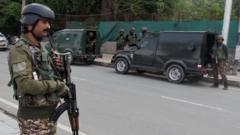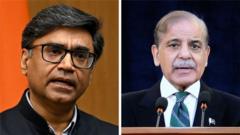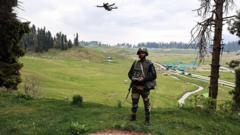### Description
### Title

### Title
India and Pakistan Reach Tenuous Cease-Fire Amid Ongoing Tensions
Amid one of the most intense military confrontations in recent years, India and Pakistan announce a cease-fire, although sporadic violence continues in the border regions.
### Summary
On May 10, 2025, India and Pakistan confirmed a cease-fire after four days of severe conflict characterized by drone strikes and missile attacks. Despite the agreement, reports indicate that violations are ongoing, particularly in the disputed region of Kashmir.
---
MULTAN, PAKISTAN — A moment of celebration erupted in both India and Pakistan as officials announced a cease-fire on Saturday, concluding several days marked by the most extensive military engagement in decades. The Indian foreign secretary, Vikram Misri, verified the cessation of hostilities but acknowledged reports of ongoing sporadic violence along their disputed borders.
Exchanging congratulatory messages over social media, both nations expressed hopes for peace. Pakistan's Prime Minister, Shehbaz Sharif, publicly thanked U.S. President Donald Trump for his mediation efforts, suggesting that American diplomacy played a crucial role in achieving the truce. While the cease-fire was hailed globally, incidents of shelling were reported on both sides later in the night, raising concerns about the sustainability of the agreement.
The escalation began last month following a brutal attack that left multiple Indian civilians dead in Kashmir, which India attributed to Pakistani militants. Subsequent military responses led to aerial bombardments and drone incursions across the region, culminating in casualties and significant infrastructure damage; figures from both sides differed greatly regarding the human and material costs incurred during the fighting.
U.S. Secretary of State Marco Rubio detailed how intense diplomatic efforts unfolded over two days, involving direct discussions with leaders from both countries to encourage restraint and initiate broader talks on a range of bilateral issues.
As reports of continued cross-border fire persisted, regional leaders called for immediate adherence to the cease-fire terms, emphasizing that any further violations could exacerbate tensions and hinder diplomatic resolutions. Despite cautious optimism, the groundwork for lasting peace remains highly fragile, with ongoing investigations into the recent attacks highlighting unresolved grievances and mutual distrust.
Following the cease-fire announcement, Pakistan reopened its airspace for all flights, reversing wartime closures that had crippled travel and air logistics. However, the road ahead is uncertain as analysts speculate on the durability of this fragile truce, driven by geopolitics and historical animosities.
The return to violence or isolation on either side could reshape future engagements, reflecting long-standing contentious sentiments over Kashmir and wider regional stability. As internal and external pressures mount, the next few days may prove critical in determining whether this cease-fire establishes a pathway to genuine dialogue or returns both countries to the brink of conflict once more.
### Summary
On May 10, 2025, India and Pakistan confirmed a cease-fire after four days of severe conflict characterized by drone strikes and missile attacks. Despite the agreement, reports indicate that violations are ongoing, particularly in the disputed region of Kashmir.
---
MULTAN, PAKISTAN — A moment of celebration erupted in both India and Pakistan as officials announced a cease-fire on Saturday, concluding several days marked by the most extensive military engagement in decades. The Indian foreign secretary, Vikram Misri, verified the cessation of hostilities but acknowledged reports of ongoing sporadic violence along their disputed borders.
Exchanging congratulatory messages over social media, both nations expressed hopes for peace. Pakistan's Prime Minister, Shehbaz Sharif, publicly thanked U.S. President Donald Trump for his mediation efforts, suggesting that American diplomacy played a crucial role in achieving the truce. While the cease-fire was hailed globally, incidents of shelling were reported on both sides later in the night, raising concerns about the sustainability of the agreement.
The escalation began last month following a brutal attack that left multiple Indian civilians dead in Kashmir, which India attributed to Pakistani militants. Subsequent military responses led to aerial bombardments and drone incursions across the region, culminating in casualties and significant infrastructure damage; figures from both sides differed greatly regarding the human and material costs incurred during the fighting.
U.S. Secretary of State Marco Rubio detailed how intense diplomatic efforts unfolded over two days, involving direct discussions with leaders from both countries to encourage restraint and initiate broader talks on a range of bilateral issues.
As reports of continued cross-border fire persisted, regional leaders called for immediate adherence to the cease-fire terms, emphasizing that any further violations could exacerbate tensions and hinder diplomatic resolutions. Despite cautious optimism, the groundwork for lasting peace remains highly fragile, with ongoing investigations into the recent attacks highlighting unresolved grievances and mutual distrust.
Following the cease-fire announcement, Pakistan reopened its airspace for all flights, reversing wartime closures that had crippled travel and air logistics. However, the road ahead is uncertain as analysts speculate on the durability of this fragile truce, driven by geopolitics and historical animosities.
The return to violence or isolation on either side could reshape future engagements, reflecting long-standing contentious sentiments over Kashmir and wider regional stability. As internal and external pressures mount, the next few days may prove critical in determining whether this cease-fire establishes a pathway to genuine dialogue or returns both countries to the brink of conflict once more.























